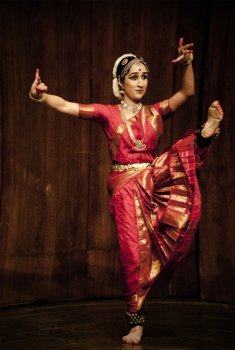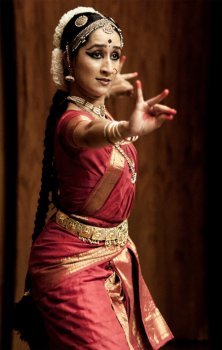
|   |

|   |
A warm programme on a cold evening! - A Seshan, Mumbai e-mail: anseshan@gmail.com Photos: Harkiran Singh Bhasin January 11, 2012 Lovers of Kuchipudi were treated to an outstanding performance by Amrita Lahiri at the Little Theatre of the National Centre for the Performing Arts in Mumbai on January 6, 2012. It followed a scintillating tabla solo by Sadanand Naimpalli of Farrukhabad Gharana, who presented a variety of peshkars, kayadas, chalans, chakradhars etc., of different schools with brief but informative introductory remarks. His mastery of the percussion instrument and vigorous recital of rhythmic syllables kept the audience spellbound for nearly an hour. It provided a good warm-up for the subsequent programme of melody and rhythm. Amrita belongs to the sishya parampara of Vempati Chinna Satyam and has had training under eminent gurus like Anuradha Nehru, Swapnasundari and lately under Jaikishore Mosalikanti. She studied Bharatanatyam (BN) also under Leela Samson. She is the Head of the Dance Programming Unit of NCPA and has, in the last two years, introduced innovative programs that attract audiences to a theatre situated at the far end of the island city in the south.   The evening started with a sloka in praise of Goddess Saraswati in evocative Valaji followed by an invocatory obeisance to Her. The kriti was Dikshitar’s “Sri Saraswati” in Arabhi set to Rupakam. The dancer portrayed the noble features of the goddess and her skill in veena playing. It was followed by the traditional Tarangam. Amrita gave a concise introduction to every item of the evening with hasta mudras and movements of the arms that enabled the audience understand the subsequent dance. She said that Tarangams were generally from Narayana Tirtha’s Krishna Leela Tarangini but she was going to present one on goddess Durga. She narrated the story of Durga vanquishing the demon Mahisha in a battle. Before Tarangam proper she danced portraying the birth of Durga and her battle. The sancharis effectively conveyed the story. “Jaya Jaya Durge” was in Ragamalikai set to adi tala. Before stepping on the brass plate she gave evidence of her technical virtuosity by dancing with interlocked toes and on the big toe. The audience could follow this difficult footwork easily as she had explained it earlier. Devatahasta mudras to depict Vishnu, Siva and Brahma coming together to create Durga, the Ananthasayana of Vishnu and others were all done in a perfect fashion, as prescribed in the sastras. The battle scene was brief but arrested the attention of the audience. The fairly long dancing on the brass plate and the sancharis were artistically performed with technical finesse. There were occasional sculpturesque poses. They were not in the original Kuchipudi style but have now become a part of it thanks to the influence of BN. Such eclectic approach is welcome as it enhances the interest of the rasikas. The recital of jatis by the nattuvanar was vibrant. She danced to the repeat performance of the jatis on the mridangam after they had been recited by the nattuvanar. The program was finished with a Tillana in Behag (Adi). The standard neck, shoulder and eye movements were executed well with a smattering of stylish talukkus. Tillana is basically a BN item but, over the years, it has come to be incorporated in Kuchipudi. Hence it was natural to follow the former’s techniques. Otherwise Amrita’s Kuchipudi idiom did not show any mix of BN despite her training in both the art forms. Jarus and muzhu mandis were effortlessly executed. The utplavanas were subdued. Every one of the three items was finished in a dramatic pose as the punch line. Amrita has an attractive stage presence and a winning smile that endear her to the audience. The shimmering costume was imaginative and contributed to the total impact of the dance. The Little Theatre with a capacity to seat 100 persons was full and everyone stayed till the end. The quality of the program was enhanced by the choreography and nattuvangam of Mosalikanti and the open-throated singing of Kuldeep Pai accompanied by Haribabu (mridangam), Muthukumar (flute) and Bhavani Prasad (veena). Mumbai was going through a cold spell and it was quite a warm experience to witness the dance programme. The author, an Economic Consultant in Mumbai, is a music and dance buff. |